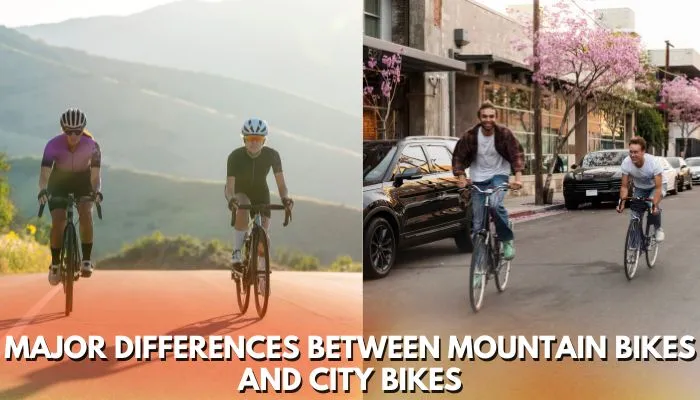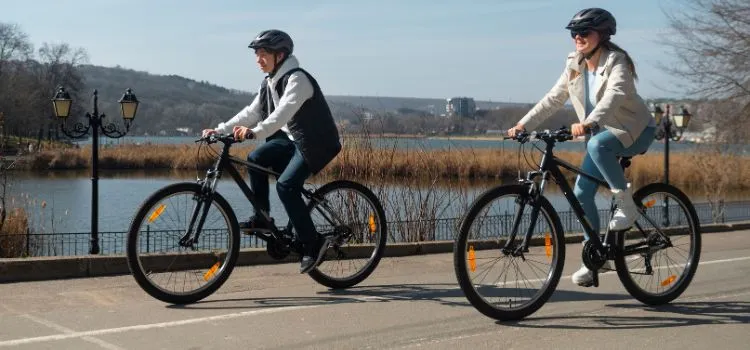Major Differences Between Mountain Bikes And City Bikes

Over the past few years, cycling has emerged as a new way of life. It is not unusual that more people are thinking about purchasing bikes on their own accord. However, for a beginner in particular, the variety of bike models can be intimidating.
Table of Contents
Short Answer
Who wins the battle in mountain bike vs city bike? A mountain bike is a particular kind of bicycle made primarily for utilization off-road on challenging surfaces, which includes rocky routes, steep gradients, and dirt pathways. Additionally, they include a variety of gears to manage steep ascents and descents. As opposed to this, a city bike, usually referred to as a commuting bike, is a sort of bicycle made for paved streets and city settings. They have a much more comfortable riding status, tires that are smooth, and a light framework.
So if you are not sure which bike you should buy for your intended purposes, first, you need to have a brief understanding of both bikes. In this article, you will get to know everything that is important to know about mountain bikes and city bikes.
Mountain Bike Vs City Bike
Mountain bikes and city bikes are basically designed for several purposes and therefore offer different features to bike riders. Mountain bikes are intended for off-road bike riding on tough terrain, which may include dirt trails, rocky routes, and inclined paths.
They generally have wider, knobby bike tires for enhanced traction and a powerful suspension system to absorb the effects of harsh terrain. Mountain bikes also have a much more upright riding framework, which can deliver better balancing and control on uneven surfaces.
They often have a wide variety of biking gears to enable riders to handle steep inclines and tough terrain. Moreover, they may also feature disc brakes for better-halting power.
On the other extreme, city bikes are designed for riding on flatter terrain, like roads and biking paths. They generally have narrow bike tires with smoother treads for enhanced speed and efficiency.
City bikes also have a more relaxed riding posture so that the rider can sit in a straight position for better comfort and visuals. They usually have fewer gears as compared to mountain bikes, as the ground is flatter and might feature a more conventional rim braking system.
Ultimately, the choice of a mountain bike and a city bike is based on the type of riding you wish to do. A mountain bike is the better alternative if you prefer off-roading and tackling tough terrain. If you just want to ride on roads or biking routes and enjoy speed and comfort, a city bike may be the one for you.
Major Differences Between Mountain Bikes And City Bikes

Here are the 7 major distinctions between mountain bikes and city bikes:
- Sole Purpose:
Mountain bikes are basically designed for off-road bike riding on harsh terrain. On the other hand, city bikes are made for riding on smoother and flatter terrain, which may include roads and bike paths.
- Bike Tires:
Talking about Mountain bikes they have wider, knobbed tires for better traction on challenging terrain. On the other hand, city bikes have narrow bike tires with smoother treads for increased pace rates and efficiency on flat and smooth roads.
- Suspension system:
Mountain bikes typically have a superior suspension system to absorb the aftereffects of shocks from any rough terrain. While talking about city bikes, mostly come with no suspension systems or only a front suspension fork to control minor bumps.
- Riding posture:
Mountain bikes have a much more upright riding posture, which can help to provide better balancing and maneuverability on uneven terrain. At the same time, city bikes have a much more relaxed biking position, with the bike rider sitting in a more straight position for enhanced comfort and visibility.
- Gears:
Mountain bikes usually have a vast range of gears to enable bike riders to handle steep hills and tough terrain. On the other hand, city bikes generally have fewer biking gears than mountain bikes, as the surfaces are generally flatter.
- Weight:
The weight of mountain bikes, as well as city bikes, is one of the most obvious distinctions. Unlike city bikes, mountain bikes are designed to be heavier. A city bike’s lighter frame and tyres are better suited to running quicker on flat terrain. In comparison, a mountain bike’s heavier frame and tyres are better suited to rough surfaces, sloping terrain, uphills, and significant barriers on badly maintained roads.
- Total cost:
Depending on the particular model, manufacturer, and features, city and mountain bikes can cost very different amounts of money. In general, city bikes are more affordable than mountain bikes. Due to its tough construction and extra equipment such as disc brakes, suspension, and a variety of gears, mountain bikes are usually much more expensive. These characteristics make them more appropriate for off-road excursions and difficult riding situations. A few thousand dollars can be spent on high-end mountain bikes. On the other extreme, city bikes are more reasonably priced and frequently made for riders who are cost-conscious.
Braking systems of both bikes:

The braking systems on mountain bikes and city bikes can differ in several different ways.
Mountain bikes employ disc brakes, which offer enhanced stopping capability and remain less affected by wet and muddy situations compared to conventional rim brakes.
Biking Disc brakes work by pressing brake pads on a rotor attached to the wheel hub. This design allows for much more constant and potent braking, which is essential for the hard terrain and steep descents that mountain bikes can easily handle.
City bikes, on the other extreme, generally use rim brakes, which basically work by pressing braking pads against the rim of the wheel.
The design is simple and light as compared to disc brakes and is enough for the lesser speeds and flat terrain that city bikes are designed for. Rim brakes are less expensive to keep up and repair but can be less efficient in damp conditions and easily wear down the rims over time.
Several city bikes might also use disc brakes, particularly if they are intended for harsher bike riding or commuting in rainy or hilly environments. Yet, rim brakes are still more commonly used on city bikes because of their cheap pricing and simplicity.
Who Should Use A Mountain Bike?
Mountain bikes are generally designed for off-road bike riding. Such off-road obstacles may include rough and uneven grounds, steep inclines, and obstacles such as rocks and tree roots. So, these bikes are perfect for people who prefer outdoor activities such as mountain biking, cross-country biking or trail racing.
Moreover, mountain bikes are well known among bike commuters who use them for regular transportation in places with rough roads or off-road trails. In addition, they can be employed for recreational purposes, such as touring and bike packing or leisure bike riding.
However, if you just ride on paved or smooth paths, a road bike or hybrid bike might be a better alternative for you. It is also essential to note that mountain biking can be quite demanding and need a specific skill. So beginners might want to start with a simpler bike or consider taking proper lessons to boost their confidence and riding ability.
Who Should Use City Bikes?
City bikes, also referred to as urban bikes or commuting bikes, are generally designed to employ in urban environments such as city streets, biking lanes, and local parks. These bikes are perfect for individuals who use bikes for daily commuting, running errands or riding around the city for enjoyment.
City bikes are designed with comfort and convenience riding in mind. So they feature upright handlebars, wider seats, and a step-through frame for better mounting and dismounting. They also typically have bike fenders to safeguard the bike rider from splashes and surrounding debris and a back rack for carrying bags or other items.
Talking about mountain bikes vs city bikes, city bikes are best for riders of all driving levels and ages. It is because they are easy to ride and do not demand any specialized items or clothing. They are also a well-demanding choice for individuals who want to ride a bike for exercising or to reduce their carbon footprint without the requirement for high-performance features or off-roading capabilities.
Which Bike Is Better?
The selection between a mountain bike and a city bike depends on your individual needs and specific use. A mountain bike will be the best choice if you want to ride on harsh and uneven terrain, steep inclines, and obstacles like rocks and tree roots. Mountain bikes are designed for off-road bike cycling and provide different features such as suspension, knobbed tires, and a strong frame that are well-suited to such type of riding.
On the other hand, a city bike would be a better option if you want to use your bike solely for commuting, running errands, or leisure riding around the city. City bikes are intended for use in urban surroundings, with capabilities such as upright handlebars, wider seats, and fenders that make them quite comfortable and convenient for regular use.
Ultimately, the ideal bike for you will depend on your particular needs and preferences. It is also important to note that factors such as where you are intending to ride, how often you want to ride, and what special features are necessary for you when making this decision.
Conclusion:
Now you know which bike will better suit you in the battle, mountain bike vs city bike. Well, it totally depends on your personal requirements and choices. If you love to trail race or go off-road, then a mountain bike is the best option for you.
On the other hand, if you love daily commuting, leisure riding as well as comfortable bike riding on smooth surfaces, city or commuter bikes is the one for you. All in all, both are the best bikes, but only choose the one which you need and will best suit your needs.
